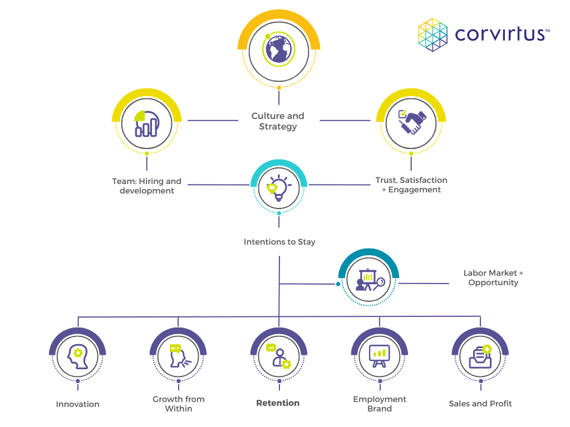Updated November, 2023
With continued economic uncertainty and declines in employee job seeking activity and turnover, it may be more difficult than before to recruit, hire, and develop your next high potential. How would losing a top performer in each area of your business affect results? What opportunities might your team be leaving behind by lacking a fully engaged workforce? Consider this -
- As much as 10 percent of productivity is driven by the top one percent of your team.
- Similarly, above average performers are ready to innovate. They have the mastery and expertise needed to combine existing ideas and respond fluidly to change. A recent McKinsey study linked this innovation to strong performers generating two times the revenue of average performers.
- On top of that, high performers are more willing to flex and adapt for what your company needs. Specifically, one study found nearly half of willing to relocate to a different region or state for a new opportunity. Focusing on keeping and earning the commitment of your team is crucial regardless of the labor market.
Now may be an ideal time to review how you're tracking turnover. It's important to know how many people are leaving on their own accord (voluntary turnover) and how many are being shown the door (involuntary turnover).

Cover Photo by Beth Macdonald on Unsplash Above Photo by Christina @ wocintechchat.com on Unsplash
When it comes to involuntary turnover, organization and documentation are key. Code the reasons for termination in detail and provide detailed notes. And hey, make sure everyone is on the same page with the coding system so you can crunch the numbers and uncover the most common reasons for bidding farewell. This intel will help you spot the trends - whether it's performance issues, attendance hiccups, unhappy customers, or simply not vibing with your company's values and beliefs (aka not a culture-fit).
To get the scoop on why employees are leaving voluntarily, you have a couple of options. The formal route involves conducting exit interviews, or surveys, on their last day or shortly after they're gone. We've implemented exit research strategies for small to large organizations and find high response rates when deployed at a week after severance. Another option: managers can simply ask departing employees about their reasons for leaving and make sure to document it all clearly and consistently (using that nifty coding system we mentioned earlier).
Questions You Should Be Asking to Solve the Retention Puzzle
Now let's get down to details and ask some important questions when it comes to evaluating turnover. These questions are not only for your employees but also for yourself:
1. Are your employees leaving because they found another job opportunity? And if so, could you have provided them with a similar role within your organization?
2. Are they saying goodbye for greener pastures and better pay or benefits? If that's the case, could your company have sweetened the deal by offering them a higher salary or improved perks like more vacation time or flexible schedules?
3. Is leadership to blame for their departure? To uncover this, you might need to conduct a exit survey, like we shared earlier; or, take a proactive approach and conduct an employee experience survey – more details below.
4. Are they bidding farewell because of the quality of your company's customer experience, product, or service? Or, is it because of lacking equipment and resources? (Employees might not feel comfortable sharing this information openly, so utilizing tools like exit surveys or employee experience surveys can help you gather valuable insights)
Building Trust, Satisfaction, and Engagement
Understanding the reasons behind turnover is important, but it's a reactive approach to improving retention and engagement. Take a look at the model below to see how perceptions of trust, satisfaction, and engagement directly impact whether employees decide to stick around or not.

The Role of Trust, Satisfaction, and Engagement
Understanding the reasons behind turnover is important, but it's a reactive approach to improving retention. Take a look at the model below to see how perceptions of trust, satisfaction, and engagement directly impact whether people stay committed to building a future with your team. Understanding the trust, satisfaction, and engagement levels of your current employees, and identifying which aspects of the work environment are linked to these attitudes, addresses employee concerns before they become intentions to leave.

Photo by Kylie Haulk on Unsplash
You can achieve this through employee experience surveys (often called engagement or satisfaction surveys; we call them experience surveys because of our aperture on capturing all an employee's whole experience). With the results of these surveys, you'll know what needs improvement – and you won't be relying solely on turnover data and the opinions of management. For example, let's say you discover high levels of dissatisfaction with pay and benefits. With the survey data, you can determine if this dissatisfaction is related to higher intentions to leave or lower engagement. Dissatisfaction with pay and benefits is sometimes a result of a poor work environment – people feel they aren't paid enough considering their subpar coworkers, leadership, and policies. With a survey, you can determine if pay is the main reason or if another factor is driving it.
Once you have this information, you can pinpoint areas of opportunity to boost employee trust, satisfaction, engagement, and retention.
When it comes to employee retention – and more specifically, building trust and increasing satisfaction and engagement – there are four main areas employers should focus on. To learn more and continue reading, check out the following resources:
- Four Focus Areas for Retaining Employees (white paper)
- Resources for Strengthening Employee Engagement + Retention




